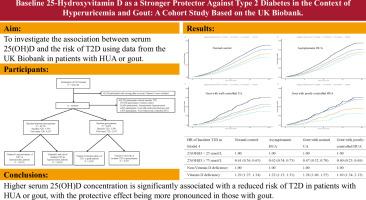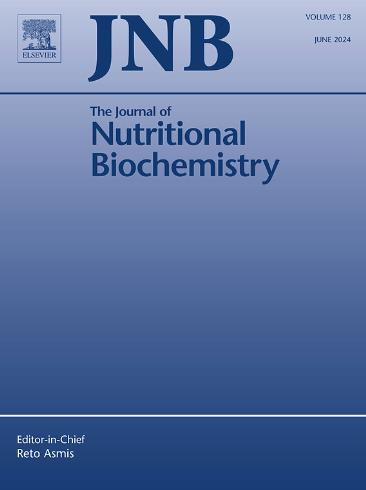Baseline 25-hydroxyvitamin D as a stronger protector against type 2 diabetes in the context of hyperuricemia and gout: a cohort study based on the UK biobank
IF 4.9
2区 医学
Q1 BIOCHEMISTRY & MOLECULAR BIOLOGY
引用次数: 0
Abstract
To elucidate the association between Vitamin D and the risk of Type 2 diabetes (T2D) in individuals with hyperuricemia or gout. A total of 43,731 patients with hyperuricemia and 9,695 with gout were included to assess the association between Vitamin D levels and T2D risk. Serum 25(OH)D (nmol/L) concentrations were measured. Multivariable logistic regression, cumulative incidence curves, Cox proportional-hazards models, and restricted cubic spline analysis were used to evaluate the relationship between 25(OH)D and T2D risk. Sensitivity and stratified analyses were performed to ensure the robustness of the findings. Higher serum 25(OH)D concentration was associated with lower risk of baseline T2D. During a median follow-up of 14.27 years for hyperuricemia patients and 14.09 years for gout patients, 4,617 and 1,072 new-onset T2D cases were documented, respectively. An inverse, nonlinear dose-response relationship was found between 25(OH)D and incident T2D in hyperuricemia patients. Compared to participants with 25(OH)D<25 nmol/L, the adjusted HR for those with 25(OH)D>75 nmol/L was 0.62 (0.54, 0.72). In gout patients, the protective effect of 25(OH)D was even more pronounced [HR: 0.45(0.32, 0.62)]. Sensitivity analyses confirmed the robustness of our findings. Significant interactions were observed with age, smoking, and cardiovascular disease, while genetic susceptibility showed no interaction. The protective effect of 25(OH)D (per 10 nmol/L increase) was stronger in hyperuricemia patients aged <65 years [<65 years: 0.91 (0.89, 0.93), ≥65 years 0.96 (0.93, 0.99)] and in never smokers [Never: 0.92 (0.89, 0.95), Current: 1.00 (0.95, 1.06)]. Among gout patients, the effect was more evident in those without cardiovascular disease [No: 0.86 (0.82, 0.90), Yes: 0.92 (0.84, 1.00)]. Higher serum 25(OH)D concentration is significantly associated with a lower risk of incident T2D in patients with hyperuricemia or gout, and this association is especially pronounced among younger individuals, nonsmokers and those without cardiovascular disease.

基线25-羟基维生素D在高尿酸血症和痛风的背景下对2型糖尿病有更强的保护作用:基于英国生物银行的队列研究
背景:阐明维生素D与高尿酸血症或痛风患者2型糖尿病(T2D)风险之间的关系。方法:共纳入43731例高尿酸血症患者和9695例痛风患者,评估维生素D水平与T2D风险的关系。测定血清25(OH)D (nmol/L)浓度。采用多变量logistic回归、累积发生率曲线、Cox比例风险模型和受限三次样条分析评价25(OH)D与T2D风险的关系。进行敏感性和分层分析以确保结果的稳健性。结果:较高的血清25(OH)D浓度与较低的基线T2D风险相关。在高尿酸血症患者14.27年和痛风患者14.09年的中位随访期间,分别记录了4617例和1072例新发T2D病例。在高尿酸血症患者中,25(OH)D与T2D的发生呈反比的非线性剂量-反应关系。与25(OH)D < 25 nmol/L的参与者相比,25(OH)D低于75 nmol/L的参与者的调整HR为0.62(0.54,0.72)。在痛风患者中,25(OH)D的保护作用更为明显[HR: 0.45(0.32, 0.62)]。敏感性分析证实了我们研究结果的稳健性。观察到与年龄、吸烟和心血管疾病有显著的相互作用,而遗传易感性没有相互作用。25(OH)D的保护作用(每增加10 nmol/L)在老年高尿酸血症患者中更强结论:较高的血清25(OH)D浓度与高尿酸血症或痛风患者发生T2D的风险降低显著相关,这种关联在年轻人、非吸烟者和无心血管疾病的患者中尤为明显。
本文章由计算机程序翻译,如有差异,请以英文原文为准。
求助全文
约1分钟内获得全文
求助全文
来源期刊

Journal of Nutritional Biochemistry
医学-生化与分子生物学
CiteScore
9.50
自引率
3.60%
发文量
237
审稿时长
68 days
期刊介绍:
Devoted to advancements in nutritional sciences, The Journal of Nutritional Biochemistry presents experimental nutrition research as it relates to: biochemistry, molecular biology, toxicology, or physiology.
Rigorous reviews by an international editorial board of distinguished scientists ensure publication of the most current and key research being conducted in nutrition at the cellular, animal and human level. In addition to its monthly features of critical reviews and research articles, The Journal of Nutritional Biochemistry also periodically publishes emerging issues, experimental methods, and other types of articles.
 求助内容:
求助内容: 应助结果提醒方式:
应助结果提醒方式:


